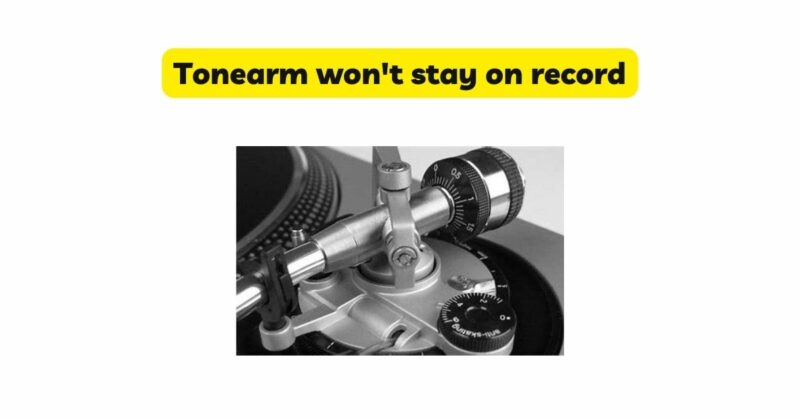Experiencing difficulties with your tonearm staying on the record can be frustrating when you’re trying to enjoy your vinyl collection. The tonearm is a crucial component of a turntable, responsible for accurate tracking and smooth playback. If you’re encountering issues where the tonearm won’t stay on the record or keeps skipping, several factors could be at play. In this troubleshooting guide, we will explore common reasons why the tonearm won’t stay on the record and provide practical solutions to help you resolve the problem and enjoy uninterrupted playback.
- Tracking Force
Insufficient tracking force is a common reason why the tonearm may not stay on the record. Tracking force refers to the downward pressure exerted by the tonearm on the record surface. If the tracking force is too low, the stylus may not have enough weight to maintain contact with the record groove, causing the tonearm to lift or skip. Refer to your turntable’s user manual or the cartridge manufacturer’s instructions to determine the recommended tracking force for your specific cartridge. Use a tracking force gauge to ensure the proper setting.
- Anti-Skate Adjustment
The anti-skate adjustment on a turntable helps counteract the inward force exerted on the tonearm by the record groove. If the anti-skate adjustment is not properly set, it can cause the tonearm to pull towards the center of the record or the outer edge, leading to instability and the inability to stay on the record. Refer to your turntable’s user manual or the manufacturer’s instructions to adjust the anti-skate mechanism correctly, matching it to the tracking force and cartridge requirements.
- Tonearm Balance
Proper tonearm balance is essential for accurate tracking and stable playback. If the tonearm is improperly balanced, it can result in the tonearm not staying on the record or causing skips. Balancing the tonearm involves adjusting the counterweight at the rear of the tonearm to achieve neutral balance. Consult your turntable’s user manual for instructions on how to balance the tonearm correctly. Take your time to achieve the proper balance, as an imbalanced tonearm can cause various tracking problems.
- Stylus Condition
A worn-out or damaged stylus can lead to tracking issues and prevent the tonearm from staying on the record. Inspect the condition of the stylus using proper lighting or a magnifying glass. Look for any signs of wear, such as a bent or broken tip, flattened edges, or excessive dirt accumulation. If the stylus is worn or damaged, it may need to be replaced. Refer to the manufacturer’s guidelines or consult a professional to ensure you select the correct stylus for your cartridge.
- Record Condition
The condition of the record itself can also affect the ability of the tonearm to stay on the surface. Scratches, warps, or other imperfections on the record can cause the stylus to skip or the tonearm to lift. Ensure that your records are clean and free from dust, dirt, or debris. Avoid playing records with significant damage or warping, as they can cause tracking problems. Regular cleaning and maintenance of your records can help prevent issues related to their condition.
- Vertical Tracking Angle (VTA)
The Vertical Tracking Angle (VTA) refers to the angle at which the stylus sits in the record groove. Incorrect VTA can lead to tracking problems and instability, causing the tonearm to lift or skip. Some turntables allow for VTA adjustment, while others have fixed tonearm heights. If your turntable has adjustable VTA, consult the user manual or manufacturer’s instructions to determine the correct setting for your cartridge and adjust it accordingly.
- Tonearm Wiring and Connections
Check the wiring and connections of your tonearm to ensure they are secure and properly connected. Loose or faulty wiring can cause intermittent signal loss or instability, leading to the tonearm not staying on the record. If you suspect any issues with the tonearm wiring, consult the turntable manufacturer or a professional technician for assistance.
- Turntable Platter and Belt
The turntable’s platter and belt play a crucial role in providing stable rotation and accurate tracking. A loose or misaligned platter or a worn-out or slipping belt can cause the tonearm to lift or skip. Inspect the platter to ensure it is properly seated and aligned. Check the belt for signs of wear or stretching and replace it if necessary. Refer to the turntable’s user manual for instructions on platter and belt maintenance or consult a professional technician for assistance.
Conclusion
Encountering issues where the tonearm won’t stay on the record can be frustrating, but by following the troubleshooting steps outlined in this guide, you can often resolve the problem. Ensure proper tracking force and anti-skate adjustment, balance the tonearm correctly, inspect the stylus and record condition, check VTA if applicable, verify tonearm wiring and connections, and examine the turntable platter and belt. By addressing these factors, you can improve the stability and tracking performance of your tonearm, allowing it to stay on the record and provide an optimal listening experience.


